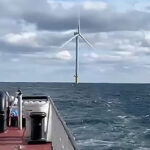Report: Britain generates record volume of renewable electricity
Energy Disrupter
ADVERTISEMENT
Academics from Imperial College London for Drax Electric Insights, commissioned via Imperial Consultants, analysed the data which highlights the turbulence that Britain’s electricity system has endured amid an unprecedented year for the energy industry.
Renewable power sources – wind, solar, biomass and hydro – generated 40 percent of the country’s electricity in 2022 – up from 35 percent in 2021, helping to cut CO2 emissions from the power sector by 2.7 million metric tons compared to the previous year. Overall generation from renewables has more than quadrupled over the last decade.
At one stage during May, renewables provided 72.8 percent of power to the grid whilst wind farms generated a landmark 20GW of electricity for the first time – the maximum output from wind is now up by a third compared to four years ago.
Despite the record supply of cheap renewable electricity, the unprecedented rise in the cost of gas following Russia’s invasion of Ukraine sent power prices to a new all-time high. The fossil fuel supplied 42% of the country’s power this year, its largest share of the fuel mix since 2016. Britain is on course to have annual average wholesale price above £200 per MWh for the first time ever in 2022 – up from £113 the year before. This is nearly six times higher than the cost of electricity in 2020 (£34 per MWh).
Iain Staffell of Imperial College London, and lead author of the quarterly Drax Electric Insights report series, said, “This has been a year like no other for the energy industry. The public are feeling the pain of high gas prices on their energy bills even though renewables are providing the grid with more cheap, green electricity than ever before.
“The lesson from 2022 is that we need to break our addiction to fossil fuels once and for all if we want lower cost and more secure energy supplies. If we had not invested in wind, solar and biomass over the last decade our energy bills would have been even higher, as would the risk of blackouts over winter.
“The energy crisis cannot be solved by increasing our reliance on gas imported from abroad. We need to turbocharge our investment in clean energy technologies to become Europe’s renewable electricity powerhouse, which will cut fuel bills at home and bring money into the economy by exporting power to our neighboring countries.”
For the first time in more than a decade, Britain is a net exporter of electricity to its European neighbors. Electricity exports quadrupled from last year to 17.2 TWh of electricity – generating around £3.1bn for the UK economy. The country exported a net total of 1.9TWh, representing a dramatic swing in power trading from the previous year when Britain instead imported a net total of 22.9TWh.
Will Gardiner, Drax Group CEO, said, “Drax plays a critical role in supporting the UK energy system, generating more renewable power by output than any other company.
“We can accelerate and strengthen Britain’s long-term energy security by ending our reliance on expensive, imported fossil fuels and instead increase investment in homegrown renewables, and innovative green technologies such as bioenergy with carbon capture and storage (BECCS) and pumped storage hydro.”
Drax is the UK’s biggest renewable power producer by output, generating enough renewable electricity from biomass and hydro for around 5 million homes – producing as much as 20% of the country’s renewable electricity during times of peak demand in 2022.
Drax plans to invest billions of pounds expanding its pumped hydro storage capacity at its Cruachan power station in Scotland and deploying BECCS at its power station in North Yorkshire, to permanently remove 8million tonnes of carbon dioxide from the atmosphere each year by 2030, whilst generating the reliable, renewable power the country needs.
















